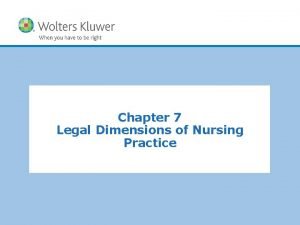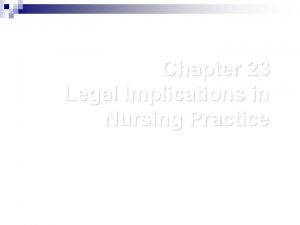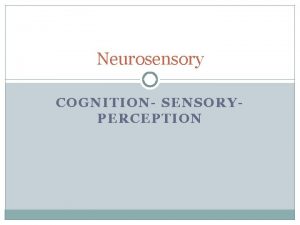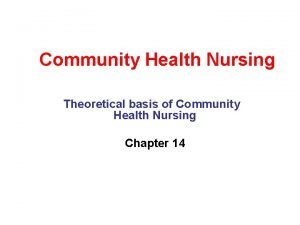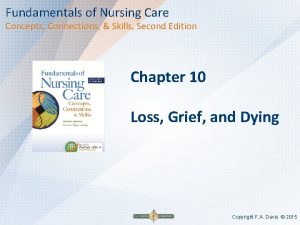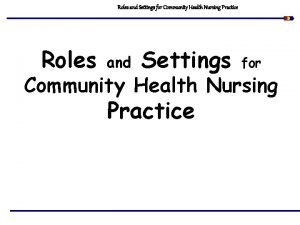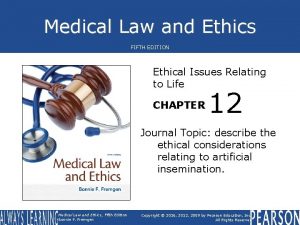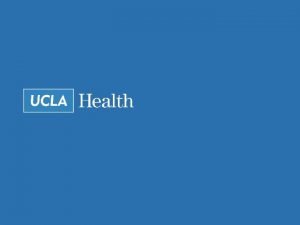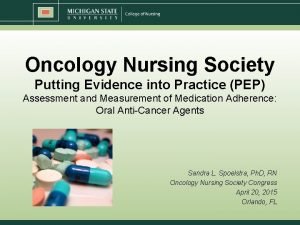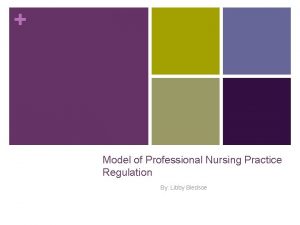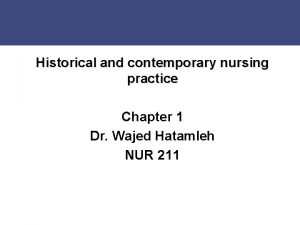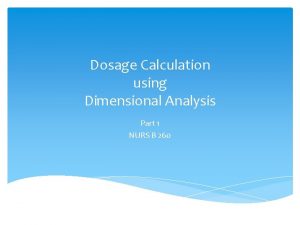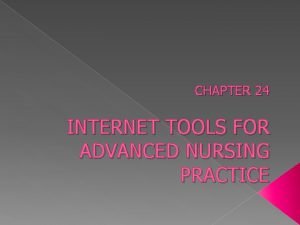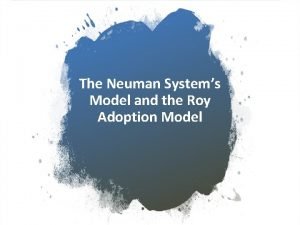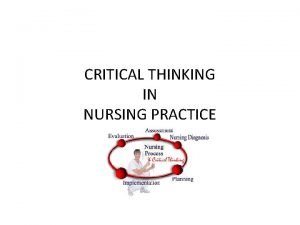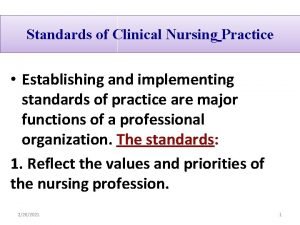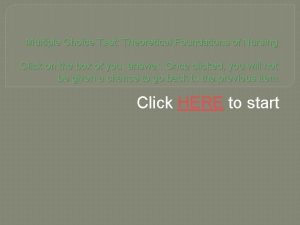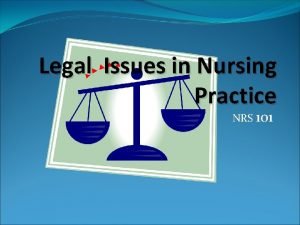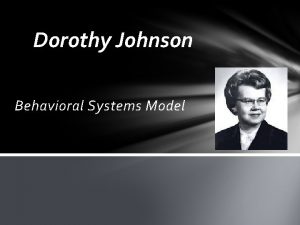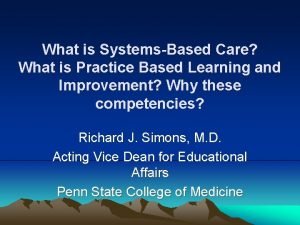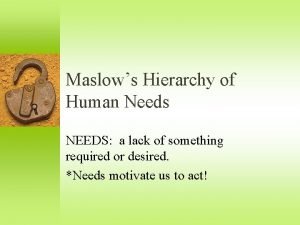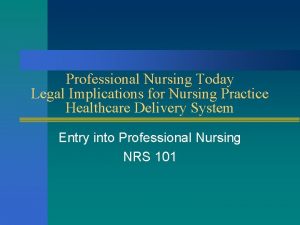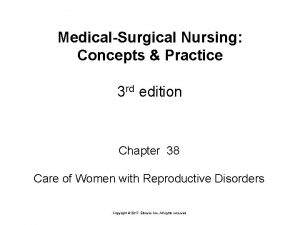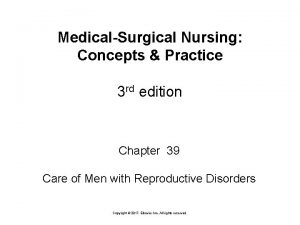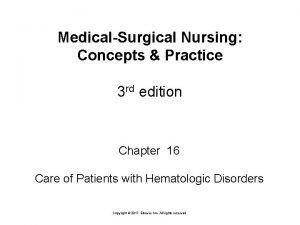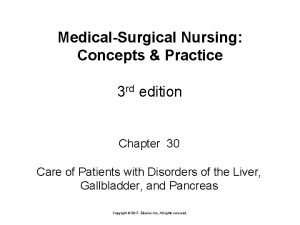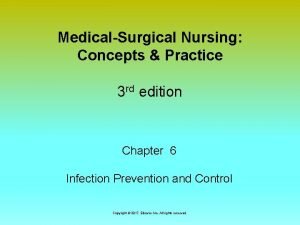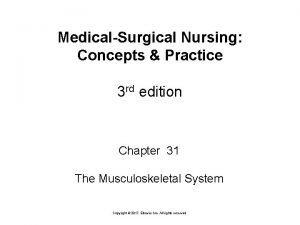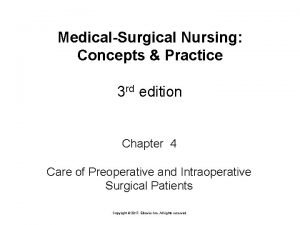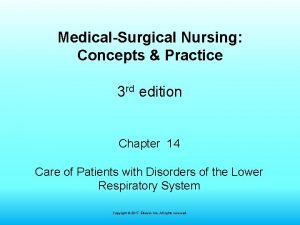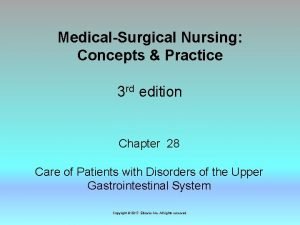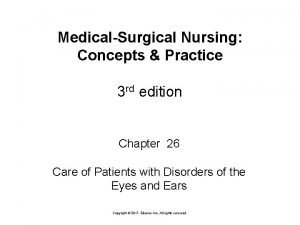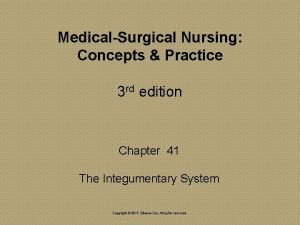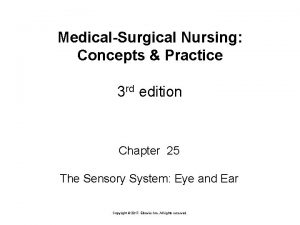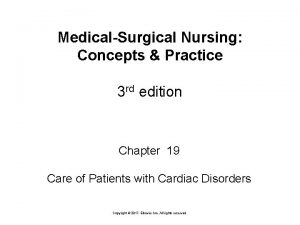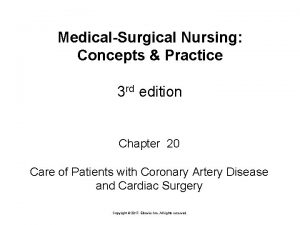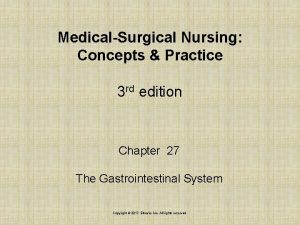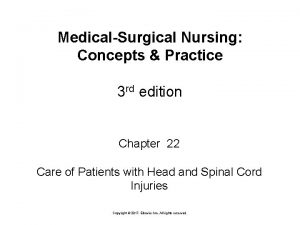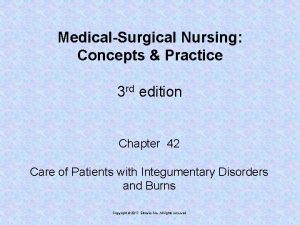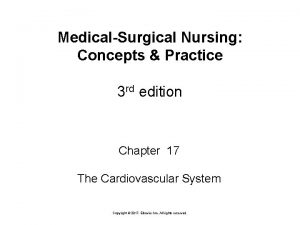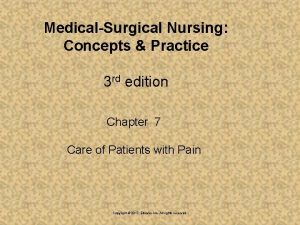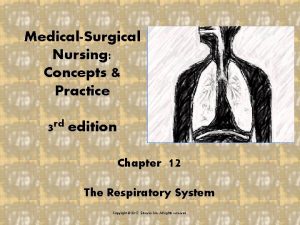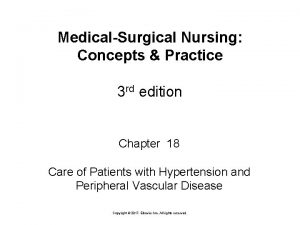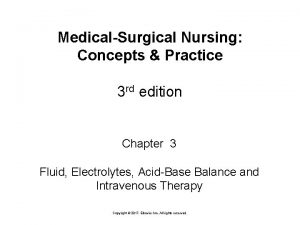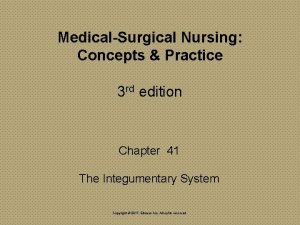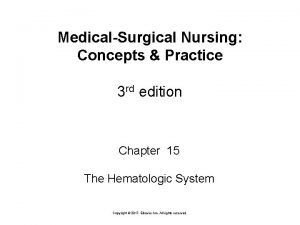MedicalSurgical Nursing Concepts Practice 3 rd edition Chapter












































- Slides: 44

Medical-Surgical Nursing: Concepts & Practice 3 rd edition Chapter 30 Care of Patients with Disorders of the Liver, Gallbladder, and Pancreas Copyright © 2017, Elsevier Inc. All rights reserved.

Theory Objectives Explain the plan of care for the patient with cholelithiasis. Describe treatment for the patient with cholecystitis. List the ways in which the various types of hepatitis can be transmitted. Identify signs and symptoms of the various types of hepatitis. Devise appropriate nursing interventions for the patient with cirrhosis and ascites. Indicate potential causes of liver failure. Copyright © 2017, Elsevier Inc. All rights reserved. 2

Theory Objectives (Cont. ) Differentiate the signs and symptoms of acute and chronic liver failure. Discuss the criteria used for selection of liver transplantation recipients. Devise a nursing care plan for the patient with cancer of the liver. Prepare a plan for adequate pain control for the patient with pancreatitis. Compare the treatment options for cancer of the pancreas. Copyright © 2017, Elsevier Inc. All rights reserved. 3

Clinical Practice Objectives Perform preoperative teaching for a patient who is to undergo laparoscopic cholecystectomy. Review a nursing care plan, including psychosocial concerns, for the patient who has hepatitis with jaundice. Implement a discharge teaching plan for the patient who has been in the hospital with a flare-up of chronic pancreatitis. Copyright © 2017, Elsevier Inc. All rights reserved. 4

Cholelithiasis (gallstones) and Cholecystitis(Inflammation of Gallbladder) Etiology Ø Ethnic predisposition to gallstones (Native Americans and Hispanic Americans) high cholesterol diets Pathophysiology – stones may obstruct bile flow Signs and symptoms Ø Ø Ø None to severe and unbearable pain N&V, fever, leukocytosis, jaundice Unbearable upper right quadrant pain (bilary colic) Copyright © 2017, Elsevier Inc. All rights reserved. 5

Gallstones – page 695 Copyright © 2017, Elsevier Inc. All rights reserved. 6

7

Cholelithiasis and Cholecystitis Diagnosis Ø Ø Ø Ultrasonography of gallbladder and biliary tract Computed tomography (CT) Endoscopic retrograde cholangiopancreatography (ERCP) Cholescintigraphy (hepatoiminodiacetic acid [HIDA] scan) Liver function tests and WBC elevation and sedimentation rate Copyright © 2017, Elsevier Inc. All rights reserved. 8

9

Cholelithiasis and Cholecystitis Treatment Ø Ø Ø Low Fat Diet, weight loss, restrict alcohol intake, small meals, oral medications that reduce gallstones Correction of bile obstruction by ERCP to remove stones Antibiotics only if peritonitis is present Post-cholecystectomy diet Surgery – U. S 90% laparoscopic Complications – internal bleeding, abdominal rigidity Copyright © 2017, Elsevier Inc. All rights reserved. 10

gallstones 11

Postoperative Laparoscopic Cholecystectomy Remove the bandages from the puncture sites the day after surgery and shower. Report the following signs and symptoms if they occur: redness, swelling, bile-colored drainage or pus from any surgical site, severe abdominal pain, nausea, vomiting, chills, or fever, light-colored stool, dark urine, or yellow tint to the eyes or skin because these signs may indicate obstruction of the flow of bile. Copyright © 2017, Elsevier Inc. All rights reserved. 12

Postoperative Laparoscopic Cholecystectomy (Cont. ) Normal activities may be resumed gradually. Return to work is probable at 1 week postsurgery. Stick to a low-fat diet for several weeks; slowly introduce fattier foods to determine if these cause unpleasant symptoms. Copyright © 2017, Elsevier Inc. All rights reserved. 13

Gallbladder Disease Cholecystitis 14

Nursing Management for Gallbladder Surgery Preoperative care – NPO, antiemetics for nausea or NG tube, IV fluids Postoperative care – Semi-Fowlers, deep breathing and coughing Caring for a T-tube – patient may have tubes or drains if continuing drainage is expected. Dressing absorb. Change frequently. If fresh blood appears, contact surgeon. Stool should be brown (bile), if light color bile is obstructed Copyright © 2017, Elsevier Inc. All rights reserved. 15

Hepatitis Etiology and pathophysiology Ø Ø Ø Types of viral hepatitis – page 698 Table 30 -2 Liver cells are damaged Hep B and C are the most serious forms of hepatitis, often progressing to chronic hepatitis, liver cancer and death Signs and symptoms – depend on the type of hepatitis – see page 699 Diagnosis – hx, physical and labwork (table 30 -3 pg 700) Copyright © 2017, Elsevier Inc. All rights reserved. 16

17

Hepatitis Treatment- rest to help the liver to regenerate, small meals, Zofran for nausea, antivirals medications, HEPATITIS IS AN OCCUPATIONAL HAZARD FOR ALL PEOLE WHO HAVE DIRECT CONTACT WITH PATIENTS. STANDARD PRECAUTIONS MUST BE OBSERVED AT ALL TIMES. 18

Treatment of Hepatitis There is no specific treatment for acute viral hepatitis. Nondrug measures include a well-balanced diet and rest and avoiding hepatotoxic substances, including alcohol and certain medications. Active and passive immunity Antiviral therapy Copyright © 2017, Elsevier Inc. All rights reserved. 19

Expected Outcomes Patient will maintain body weight within normal limits during illness. Patient will verbalize lessened fatigue after rest periods each day. Patient will verbalize a decrease in pain after institution of nursing measures to decrease discomforts. Copyright © 2017, Elsevier Inc. All rights reserved. 20

21

Expected Outcomes (Cont. ) Patient will verbalize knowledge of disease process and self-care within 2 days. Patient will engage in appropriate diversional activities during convalescence. Copyright © 2017, Elsevier Inc. All rights reserved. 22

Nursing Interventions Monitor progress. Prevent the spread of infection. Patient and family teaching—proper handling of body secretions, proper hand hygiene, and limiting contact Psychological support Ensure adequate nutrition Copyright © 2017, Elsevier Inc. All rights reserved. 23

Cirrhosis- Chronic Disease of the Liver Etiology Ø Ø Ø Postnecrotic cirrhosis – viral hepatitis, toxic substances, parasites or infection Laënnec’s cirrhosis or portal cirrhosis - alcohol Biliary cirrhosis – chronic biliary obstruction Cardiac cirrhosis – right sided heart failure ALCOHOLISM CAUSES DEPOSITION OF FAT IN THE LIVER CELLS. THIS IS REVERSABLE IF ALCOHOL CONSUMPTION IS HALTED Copyright © 2017, Elsevier Inc. All rights reserved. 24

Cirrhosis (Cont. ) Diagnosis Ø Ø Liver biopsy Liver function studies CT and liver scan Magnetic resonance cholangiopancreatography Treatment—stopping the liver damage and restoring the liver’s functions Copyright © 2017, Elsevier Inc. All rights reserved. 25

Signs and Symptoms Subjective symptoms Ø Ø Ø Ø Fatigue Weakness Headache Anorexia Indigestion Abdominal pain Nausea Vomiting Copyright © 2017, Elsevier Inc. All rights reserved. 26

Signs and Symptoms (Cont. ) Fluid retention in the right hemithorax or ascites can limit expansion of the chest and cause dyspnea. Objective symptoms of liver cirrhosis include excessive gas, skin rashes, itching, and fever. Leg and foot edema and palmar erythema (redness of palms) Caput medusa (blue varicose veins around umbilicus) Bleeding and bruising, urine dark, jaundice Copyright © 2017, Elsevier Inc. All rights reserved. 27

Signs and Symptoms (Cont. ) Deficiencies in vitamin K, thrombin, or prothrombin interfere with clot formation. The liver often is enlarged and “knobby” and is palpable below the level of the right rib cage. Abdominal distention The spleen also enlarges. Copyright © 2017, Elsevier Inc. All rights reserved. 28

Signs and Symptoms (Cont. ) Peripheral edema and ascites Skin lesions, jaundice, pruritus, bleeding disorders, endocrine disorders, and peripheral neuropathy occur in late disease. Spider angiomas may appear on the face, neck, upper trunk, and arms. Elevations in liver enzymes usually do not occur until 65% of liver function is gone. Copyright © 2017, Elsevier Inc. All rights reserved. 29

Signs and Symptoms of Cirrhosis Copyright © 2017, Elsevier Inc. All rights reserved. 30

Relationship of Systemic Portal Hypertension and Ascites in Cirrhosis Copyright © 2017, Elsevier Inc. All rights reserved. 31

Nursing Management of Cirrhosis Assessment Ø Ø Ø Assess for safety issues Laboratory tests Alcohol withdrawal Nursing diagnosis Planning and implementation Evaluation Copyright © 2017, Elsevier Inc. All rights reserved. 32

33

Complications of Cirrhosis Esophageal varices – engorged veins from portal congestion and hypertension, if vein walls rupture, massive bleeding Encephalopathy Ø Ø Delirium, convulsions, asterixis (tremors), and coma Fetor hepaticus (breath with a sweet, fecal odor) Copyright © 2017, Elsevier Inc. All rights reserved. 34

Treatment for Esophageal Varices – page 711 Copyright © 2017, Elsevier Inc. All rights reserved. 35

Liver Transplantation Legal and ethical considerations Nursing management Ø Ø Ø Care of drains Immunosuppressants Liver function monitoring Copyright © 2017, Elsevier Inc. All rights reserved. 36

Cancer of the Liver Etiology – usually metastatic Pathophysiology – cirrhosis or hepatitis b or c increase the risk, inflammation of normal liver cells Signs and symptoms – right upper quadrant pain, fatigue, weight loss Diagnosis - labwork, biopsy Treatment – radiation and chemotherapy Copyright © 2017, Elsevier Inc. All rights reserved. 37

Liver cancer 38

Acute Pancreatitis Etiology – alcoholism, trauma, viral infections Pathophysiology – inflammation/damage caused by the escape of pancreatic digestive enzymes Signs and symptoms- abdominal pain left upper quadrant, eating makes the pain worse Diagnosis –symptoms, ultrasound, CT, labwork Treatment – pain management, fluids, nutritional support Copyright © 2017, Elsevier Inc. All rights reserved. 39

Chronic Pancreatitis Etiology and pathophysiology – repeated bouts of inflammation causes progressive fibrosis of the gland, stricture of the ducts and eventual calcification Signs and symptoms – abdominal pain, malabsorption with weight loss Diagnosis Ø Determination of bicarbonate concentration and output in the duodenum after stimulation with secretin is the definitive test for chronic pancreatitis. Copyright © 2017, Elsevier Inc. All rights reserved. 40

Chronic Pancreatitis (Cont. ) Treatment and Nursing management Ø Ø Ø Pain management Complications, including diabetes mellitus Avoid alcohol. Copyright © 2017, Elsevier Inc. All rights reserved. 41

Chronic Pancreatitis 42

Cancer of the Pancreas Signs and symptoms epigastric pain and weight loss. High incidence of clot formation Ø Deep vein thrombosis Diagnosis Ø Ø Ultrasonography, imaging techniques, and fine-needle biopsy Elevated carcinoembryonic antigen levels elevated 80 to 90% Serum beta-human chorionic gonadotropin and carbohydrate antigen (CA) 72 -4 Tumor markers CA 19 -9 and CA 242 Copyright © 2017, Elsevier Inc. All rights reserved. 43

Cancer of the Pancreas (Cont. ) Treatment Ø Ø Keep the patient comfortable. Treat or prevent malnutrition. Surgical treatment, including Whipple procedure ( head of pancreas, the gallbladder, the duodenum, part of the jejunum and all or part of the stomach are removed), or radical pancreaticoduodenectomy Other treatments – ablation, microwave therapy Nursing management – manage pain (page 716) Community care – promote immunizations Copyright © 2017, Elsevier Inc. All rights reserved. 44
 Professional nursing practice concepts and perspectives
Professional nursing practice concepts and perspectives Political astuteness in nursing
Political astuteness in nursing Introduction to genetic analysis tenth edition
Introduction to genetic analysis tenth edition Operating system
Operating system Operating system concepts 6th edition
Operating system concepts 6th edition Chords rule in dbms
Chords rule in dbms Biology concepts and connections 4th edition
Biology concepts and connections 4th edition Using mis (10th edition) 10th edition
Using mis (10th edition) 10th edition Chapter 1
Chapter 1 Kataoka-yahiro and saylor's model
Kataoka-yahiro and saylor's model Legal safeguards in nursing practice
Legal safeguards in nursing practice Legal implications of nursing documentation
Legal implications of nursing documentation Cost-benefit analysis concepts and practice
Cost-benefit analysis concepts and practice Interrelated concepts nursing
Interrelated concepts nursing Salmon white's construct for public health nursing
Salmon white's construct for public health nursing Fundamentals of nursing care concepts connections & skills
Fundamentals of nursing care concepts connections & skills Community health nurse manager role
Community health nurse manager role Leadership theory and practice 6th edition
Leadership theory and practice 6th edition Computer security principles and practice 4th edition
Computer security principles and practice 4th edition Modern real estate practice in pennsylvania 14th edition
Modern real estate practice in pennsylvania 14th edition Ethical problems in the practice of law 5th edition
Ethical problems in the practice of law 5th edition Computer security principles and practice 4th edition
Computer security principles and practice 4th edition Joey's first 14 quiz grades in a marking period were
Joey's first 14 quiz grades in a marking period were Myeplg website
Myeplg website Unit practice council nursing ideas
Unit practice council nursing ideas Ons pep
Ons pep Model of professional nursing practice regulation
Model of professional nursing practice regulation Joint commission impact on nursing practice
Joint commission impact on nursing practice Contemporary nursing definition
Contemporary nursing definition Dosage calculation dimensional analysis
Dosage calculation dimensional analysis Internet tools for advanced nursing practice
Internet tools for advanced nursing practice Oklahoma board of nursing supervising physician
Oklahoma board of nursing supervising physician Neuman systems model case study
Neuman systems model case study Critical thinking example in nursing
Critical thinking example in nursing Standards of clinical nursing practice
Standards of clinical nursing practice Theoretical foundation of nursing practice test
Theoretical foundation of nursing practice test Legal issues in nursing practice
Legal issues in nursing practice Johnson's behavioral system model nursing practice
Johnson's behavioral system model nursing practice Translating research findings to clinical nursing practice
Translating research findings to clinical nursing practice Systems-based practice
Systems-based practice Hendersons theory
Hendersons theory Practice drift in nursing
Practice drift in nursing Abraham maslow siblings
Abraham maslow siblings Fbon
Fbon Trends and issues in nursing
Trends and issues in nursing










